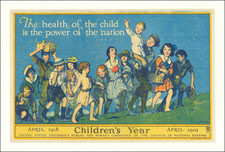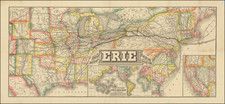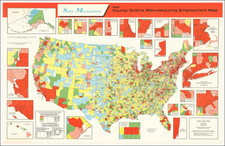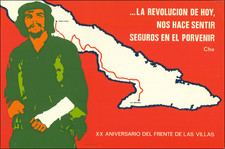Distributing The First Postal Map of the United States To Local Agents
Fascinating one page letter from Abraham Bradley, Jr. to Connecticut Postmaster Ezekiel Williams Jr., sent from Philadelphia to Hartford, Connecticut on April 22, 1797, discussing Bradley's Postal Map of the United States.
The letter addresses two subjects. The first portion of the letter addresses Williams' (unsuccessful) attempt to collect a debt from Congress, likely in connection with the operations of the post office in Connecticut.
The second subject is a discussion about sending an early copy of Abraham Bradley's Postal Map of the United States to Williams and a request by Bradley that Williams serve as an agent for the sale of the postal map on a commission basis (12.5%). The reference to M. Burrall would most likely Jonathan Burrall, who was then assistant postmaster general.
This would likely have been the first complete state of the map, which had previously been advertised as early as October 1796 (1 sheet only).
The letter reads as follows:
Philadelphia April 22, 1797
Dear Sir
Yours of the 18th instant was duly received. I immediately called at the Auditors office for the purpose of having your loan Office certificate entered according to your request; but it
seemsit culd not be received, being barred by the Act of Limitation. An act was passed the last session entitled "An Act extending the time for receiving on loan the domestick debt of the United States:" this act however contains the following proviso -- "that nothing herein contained shall be construed to extend to any evidence of publick debt, which may be barred by any act of limitation." All evidences of public debt which were not registered & renewed conformably with the 10- Sect. 34 Chap. passess 2 Session of 1 Congress are now dead & cannot be registered or loaned until revived by a new act of Congress. I therefore now return your enclosed certificate; I am sorry that I have not been able to render you service.I have made out a map which M. Burrall has franked; I will retain it a few days for an opportunity by private hand; as there is danger it may be injured if conveyed in the mail, particularly at this rainy season; if I cannot send it by a passenger I will put it in the mail. As it might be difficult to find any person in Hartford who could put the sheets together & finish it properly
???for a reasonable price, I have sent the map entire, which I beg you will accept without charge.Would it be agreeable to you to take a dozen or two of the maps for sale on the usual commission of 12 1/2 per cent? I suppose that you have some persons pretty constantly in your office, so that it might not give you much trouble.
I am sir respectfully your obedient servant
Abraham Bradley
Ezekiel Williams
Ezekiel Williams Sr. (1729-1818) a merchant in Wethersfield, Connecticut and served as a captain in the Continental Army. He was the sheriff of Hartford County from 1767 to 1789 and, during the Revolutionary War, he served as a member of the Committee of the Pay Table and Deputy Commissary General of Prisoners in Connecticut.
Ezekiel Williams‘ son, Ezekiel Jr. (1765-1843), graduated from Yale College in 1785 and married Abigail Ellsworth, daughter of Oliver Ellsworth. He would go on to serve as Postmaster of Connecticut until 1803 and was a nautical insurance insurance underwriter. The Williams Family Collection of papers is held at Trinity College.
Bradley Postal Map
Abraham Bradley's A MAP OF THE United States. Exhibiting Post Roads & Distances BY Abraham Bradley Jun. . . 1796, was the first postal map of the United States and was accompanied by the first printed time table.
Abraham Bradley was a Litchfield, Connecticut, lawyer, who had an extraordinary career as a senior civil servant in the U.S. Post Office Department. Bradley joined the Postal Department in 1792, was promoted to First Assistant Postmaster General in 1800, and served until being removed from office in the Jacksonian purges of 1829.
It is hard to overstate the importance of the Postal Department in the first decades after the revolution. The founders saw effective postal service as a precondition for an informed citizenry and vibrant democracy, and Postmaster General was one of the first Cabinet positions created by Washington. At times during Bradley's tenure, The Postal Department accounted for more than 75% of the Federal bureaucracy. By his retirement, Bradley oversaw more than 8,000 local offices and 110,000 miles of post roads. During these years, Bradley essentially acted as the Department's Chief Operating Officer, overseeing among other things route selection, contracting, finances and even responding to complaints about lost or stolen mail. In light of his position, Bradley was arguably the American most motivated to produce a viable postal map, and certainly the best informed.
First issued in 1796 (northeast sheet only), Bradley's postal map is among the most important maps in American history. The map also includes the first printing of the first American postal delivery time and route schedule (which may have also been issued separately, although there are no known separately printed examples which have survived).
The map was advertised for sale on October 3, 1796 as follows:
The above map may be had of the author at the General Post-Office…..Prices from 3 ½ to 5 dollars each, according to the manner in which they are finished. The progress (or arrivals and departures) of the Mail on the Main Line may be had separate for 37 ½ cents.
The map's true value is its exceptionally detailed depiction of the post offices and post routes of the young United States at the end of the 18th century. Buehler and Caldwell note:
What makes the map extraordinary is its depiction of the American postal system in a single coherent image. It shows every one of the roughly 450 existing post offices and every postal route, with distinctive symbols differentiating "post roads," "post roads established by contract," and "post and stage roads." Each route is marked to indicate the mileage between post offices. The varying density of the network displayed on the map serves as a profile of national expansion and development. ("Mapping a Networked Nation," p. 10)
Abraham Bradley was born in Litchfield, Connecticut. He is an important figure not only in early American cartography, but in early American history as well. Initially, Bradley trained as a lawyer and moved to the Wyoming Valley of Pennsylvania to practice. There he met Judge Thomas Pickering, who took Bradley with him to Philadelphia when he was appointed Postmaster General by George Washington in 1791.
As Pickering's clerk, Bradley created postal maps which showed the budding system of post offices and routes. A self-taught mapmaker, Bradley quickly gained considerable skill and became well-known for this carefully drawn maps. His most famous map is the postal route map of 1796, which shows the young United States and includes an innovative table that calculated the time it would take a letter to travel around the country.
In 1799, Bradley was appointed Assistant Postmaster General, a position he would hold until 1829. As part of his duties, Bradley supervised the moving of the General Post Office Department from Philadelphia to Washington DC. In 1804, with the help of British mapmaker Aaron Arrowsmith, Bradley updated his postal map, which featured in practically every post office in the states and territories. Bradley would continue to create route maps, and to update his most famous map, throughout his career, including in 1810 and 1825.
During the burning of Washington DC in the War of 1812, Bradley housed the records and archives of the General Post Office Department in his Maryland farmhouse. His service with the Post Office came to an abrupt end, however, with the election of Andrew Jackson. Although he had served under five Postmasters General, Jackson dismissed Bradley for partisan reasons. Bradley then served as secretary to the Franklin Insurance Company. He died at his farmhouse in 1838, leaving behind eight children. He is remembered for his careful custodianship of the nascent Post Office, and for creating maps that made Americans feel connected to their fellow citizens.













![United States [rare variant edition]](https://storage.googleapis.com/raremaps/img/small/83279.jpg)


![Vaisseau du Premier Rang avec ses Mats et Vergues, et quelques uns des principaux Cordages [Ship of the Line with her Masts and Yards, and Several Principal Riggins]](https://storage.googleapis.com/raremaps/img/small/88591.jpg)